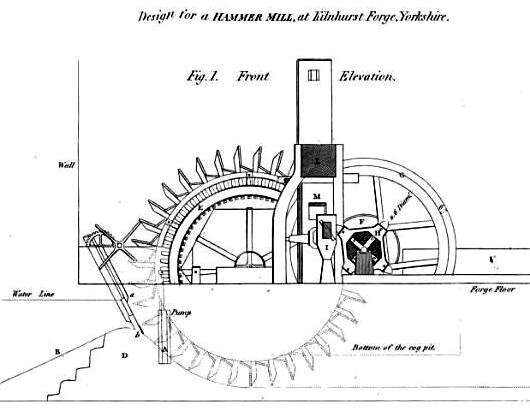Kilnhurst
Kilnhirst 12th cent. Wooded hill with a kiln. cyln + hyrst.
John Darley, ironmaster, of York, and Kilnhurst, son of William Darley, of Butter- crambe, near York married Alice, daughter of Christopher Mountfort, of Kilnhurst. John Darley bought the manor of Kilnhurst of his wife's brother, Lancelot Mountfort, Esq. who in 1584 held 3 messuages, 3 cottages, and a watermill with lands in Overhaulgh, Rawmershe, Swinton, and Kilnhirst. Source 'Yorkshire Fines: 1584'
There were two potteries here from around 1746, one owned by George Green, and the other Septimus Frost.There was also an extensive iron furnace and a corn mill .
Kilhnurst Forge
In 1720 William Westby Cotton ran Kilnhurst forge on the Don, in a twenty-one-year partnership with his brother-in-law Thomas Cotton (1701-1749).
Between 1764 and 1785, John Smeaton was designing machinery for ironworks. The earliest was the Kilnhurst Forge - Hammer Mill in 1765.

Side Elevation

Kilnhurst Forge - Hammer Mill
Fig. 1 is an elevation of the machinery in front.
Fig. 2 an elevation sideways, showing the water-wheel and conduit.
The following are those parts which are not rendered evident from an inspection of the design: a, is the breast board of the shuttle; B is a piece of an iron plate on to the nose or edge of the shuttle, to make it deliver the water in a clean sheet.
A is a pump, worked by a tappet in the water-wheel axis, to keep the cog pit free from water, when the tail water is above the bottom thereof.
The water-wheel is fifteen feet diameter out and out, and six feet wide, with 36 floats; the water line, when at a full head, is two feet above the crown of the fall /and five feet ten inches above the bottom of the wheel race; the outside stones, both upstream and downstream, of the fore bay /or breast or fall of the wheel, to be jointed with cement of terras, and the inside with good mortar, mixed with forge scales or minion; the slope B is formed by an apron of earth spread on the masonry.
The open wheel E, or the water-wheel shaft within the house, to be ten feet six inches in diameter, with 72 cogs, at five and a half inches pitch, and the wallower or trundle /which it turns, to have 25 rounds at the same pitch, and will be three feet seven and three quarter inches diameter; the fly-wheel, G, is to be eleven feet six inches outside diameter, being surrounded by a cast iron ring eight inches by six in section; the iron ring H, with 4 cogs (describing a circle of four feet eight inches diameter), is to be fixed on the end of the shaft of the fly-wheel, for lifting the hammer I; the gudgeon for the end of this shaft is to be cast upon a crop d, fig. 1, the back face of which is to be made one quarter of an inch broader than the fore face, that when the wood is wedged round it will be grasped, and held in like a dovetail, exclusive of the four screws; but if this is not preferred, a common gudgeon may be applied to the same ring.
The rest of the machinery, being the framing or harness for the hammer, is supposed to be subject to the corrections of the forge carpenter, and are only shown in the design to mark their relative places.
K are pigs of iron, to serve as a weight upon the drome beam L, and puppet post M.
In May 1826 Richard Slagg, of Kilnhurst Forge, obtained a patent for his invention of an Improvement in the manufacture of Springs chiefly applicable to Carriages. This invention, the specification of which consists in rolling bars of steel for making carriage springs, between a pair of grooved rollers, one of which rollers is to be made convex, for the purpose of forming the bar into a concave, and to these rollers are also to be adapted, horizontal rollers for making the edges of the bars uniform. This mode of making springs will it is said prevent them from getting out of order.
Kilnhurst 1822
In 1822, Kilnhurst was in the townships of Swinton and Rawmarsh, and parish of Rawmarsh, upper-division of Strafforth and Tickhill. Kilnhurst-Hall, the seat of William Turner, Esq. Situated 5 miles from Rotherham, 8 from Barnsley. Here are six Alms or Hospital-Houses, left by Edward Goodwin
Kilnhurst 1862
In 1862 Kilnhurst was described as a hamlet containing 858 inhabitants. The Church was completed in 1859, the expense (£1,400) of Earl Fitzwilliam, the patron of the living, value, £125, which is enjoyed by the Rev. T.H.F.Sheppard, for whom a neat parsonage house was been erected. Here is also a Wesleyan Chapel and a National School, the latter built in 1835. The Post Office, at Kilnhurst, at Alfred Hague's. Letters arrive at 8.0 a.m., and are despatched at 5.30p.m.
The Kilnhurst collieries were formerly called the Thrybergh Hall Collieries, where on 30th November, 1863, 6 miners were killed by falling down the shaft
Thrybergh Hall Colliery Disaster
Vanguard Works
